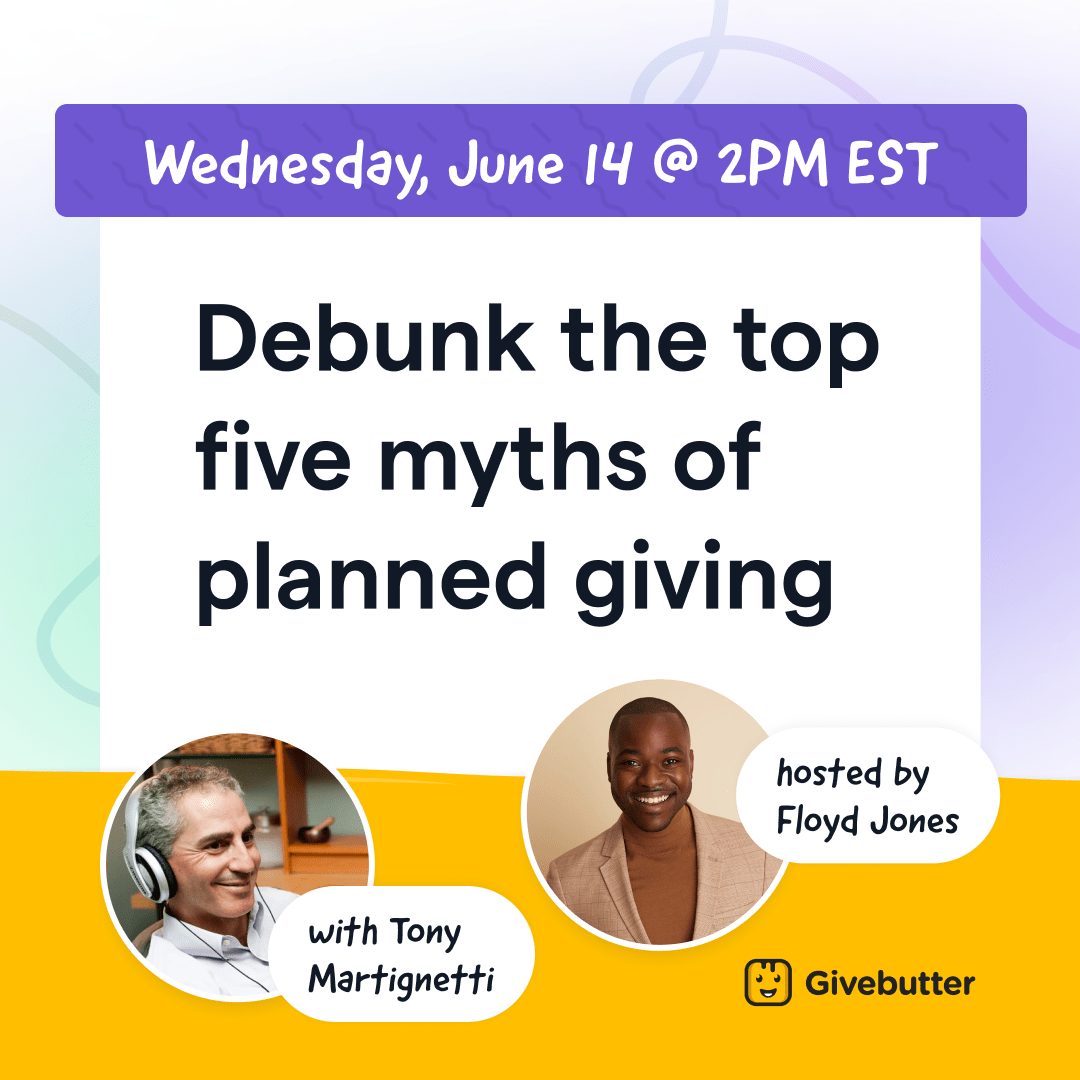Table of contents
Table of contents
In a nonprofit's journey toward fulfilling its mission, funding is like a match to a fuse. Without it, it wouldn't be possible to spread awareness in a way that sparks results. From incorporation fees and branding to staff and events, the cost of running a nonprofit can add up quickly.
To make money for your cause, you need to be prepared to spend money. But how does one raise funds necessary to sustain a nonprofit? Keep reading to learn about different sources of funding available to nonprofits, popular funding models, and five simple steps for making a fundraising plan for your organization.
Best sources of funding for nonprofit organizations
Nonprofit organizations obtain funding from a wide variety of sources. Whether you're involved in a large operation or a smaller startup organization, the best methods for funding your nonprofit will vary. There's no unanimous choice for the best mix of fundraising sources to help you meet (and even surpass) your goals. However, there are many options you can pick from to create the best funding solution for your organization's needs. These include:
- Foundation grants
- Corporate contributions
- Government grants and contracts
- Individual donations and major gifts
- Membership dues and fees
- Tax programs
- Bequests
- Selling goods and services
💡 Pro tip: Select which kind of funding model you want to adopt before you start requesting funding for your nonprofit (more on this below!).
What is a nonprofit funding model?
A funding model is a systematic and standardized approach to forming a dependable revenue foundation that supports your organization's services and programs. It's the best way to create financial stability and sustainability—two critical factors for supporting your organization's program strategy.
Like nonprofit funding sources, the best funding model for your organization depends on your mission and programs. Three different characteristics classify funding models:
- Funding type
- Funder's motivation
- Funding decision maker
Let's explore effective funding models currently used by some of the most successful and well-known nonprofits.
Top 6 nonprofit funding models according to type
From individual donors to corporate funding and government grants, these are the top nonprofit funding models according to type.
Heartfelt Connector 💛
As one of the world's largest and most successful nonprofits, Make-A-Wish thrives by helping causes that large numbers of people at all income levels can empathize with. Nonprofits like this approach fundraising using a funding model known as 'Heartfelt Connector.'
Heartfelt Connectors build explicit connections between like-minded volunteers via special fundraising events. If you're considering this method, you should ask yourself the following questions:
- Is there a large number of people who have expressed interest in funding this cause?
- Can I communicate what's compelling about this nonprofit simplistically and directly?
- Does our organization have the in-house capabilities for attempting broad outreach?
Beneficiary Builder 🏩
In nonprofits like the Cleveland Clinic, some organizations provide services to individuals, receive payment for those services, and then rely on the individuals who benefited from the services to give additional donations. A couple of prime examples of Beneficiary Builders are universities and hospitals.
Through building long-term relationships with individual beneficiaries, nonprofits receive supplemental support that helps cover their expenses.
Public Provider 🏛
Nonprofits like the Success for All Foundation work with government agencies to provide essential social services such as housing, education, and human services. These are all services the government has already defined and set aside funding for. Sometimes, the government will outsource the service delivery function and establish specific conditions for nonprofit organizations to receive the necessary funding (like a reimbursement request or a request for a proposal).
Here are some things to consider if you think this method might be right for you:
- Is our organization an organic match with one or more preexisting government programs?
- Can we prove our nonprofit can outperform the competitors?
- Can we secure contract renewals regularly?
Policy Innovator 💡
Other nonprofits, such as Youth Villages, rely heavily on funding from the government using a funding model called Policy Innovator. These organizations develop alternative methods to address social issues that aren't compatible with existing government funding programs.
Governments will often fund these organizations if they can convince government funders their methods are cheaper or provide more effective results.
Resource Recycler ♻️
Several nonprofit organizations, including Americares Foundation, have grown in size thanks to in-kind donations from individuals and corporations. These organizations distribute in-kind donations to recipients in need who would have otherwise been unable to purchase them.
While nonprofits still need to raise funds for their operating costs, the Resource Recycler method allows them to make a difference without incurring the cost of producing these resources.
Local Nationalizer 🌎
Organizations like Big Brother Big Sisters of America have grown by addressing the issues a local community faces, such as supporting low-income, under-funded schools. They receive funding through local individuals, corporate donations, and special events.
By creating an extensive, national network of locally-based operations, nonprofits can rely less on the government and more on passionate individuals and corporations looking to donate. If you're considering this method, the following questions may be helpful:
- Does our nonprofit touch on issues local leaders prioritize, and are these issues important across the country?
- Will expanding our nonprofit into other areas help us achieve our mission?
- Can our model be replicated in other areas?
- Are we committed to hiring and supporting high-quality leaders that can run local branches of our nonprofit in other areas?
How to get started on your nonprofit funding journey—5 simple steps
With so many forms to fill out and a seemingly endless sea of resources, the process can be a little overwhelming. If you're feeling lost or nervous about seeking funding for your nonprofit, please know that you don't have to do it alone. Don't get weighed down by the bureaucracy and red tape sometimes involved in the hunt for funds. Instead, try these five simple steps for a stress-free approach to obtaining funding and turning your dreams into a reality:
Step 1: Define your goals, mission, and story ✍️
When beginning the search for nonprofit funding, you must consider your short-term and long-term fundraising campaign goals. Reference your mission statement if you're struggling to come up with these goals. What do you plan to do with the money you raise? How will it help your organization's mission and purpose? Donors will also be asking these questions, so it's important to have an answer. Transparency is key in both your story and your cause.
Step 2: Create your fundraising team 🏆
Fundraising has many moving parts. Assign a productive individual—or even a small team—to oversee all fundraising efforts. This individual or team will be responsible for promoting fundraisers, organizing fundraising events, training volunteers, managing funds, and measuring fundraising performance.
Step 3: Build a prospect list 💪
What is your target donorbase for this fundraiser? Which communities, organizations, and groups should you approach for donations? With this list in hand, creating a campaign promotion plan will be easier. Whether you decide to seek funding via social media, crowdfunding, or direct mail, a prospect list helps you identify exactly who to reach out to.
Step 4: Create a campaign plan 📋
Begin by defining how you'll raise money. Think about your tactics, how you'll promote your campaign, and how people will hear about your events. Additionally, consider how you can build reliable recurring donations, so you won't need to spend as much time actively fundraising in the future.
Step 5: Show gratitude 🙌
No matter how you raise money for your nonprofit organization, you always need to say thank you. At a minimum, you should send a thank-you note and a donation receipt right after someone contributes. Take it a step further by thinking of ways to build meaningful relationships with your donors.
Nonprofit funding made easy
Whether you're a small startup or a well-established organization with a large staff and volunteers, these tips can help nonprofits of all shapes and sizes. Start raising the money you need to achieve your goals today!
Need additional support? Explore top nonprofit strategies and discover more ways to fund your nonprofit.





.png)




%20(1).png)






.png)






.svg)
.svg)
